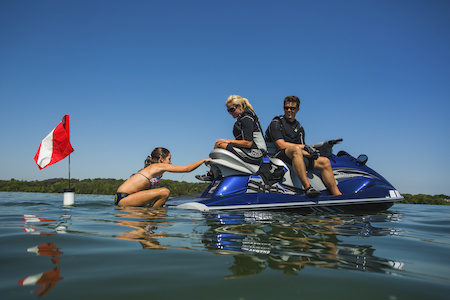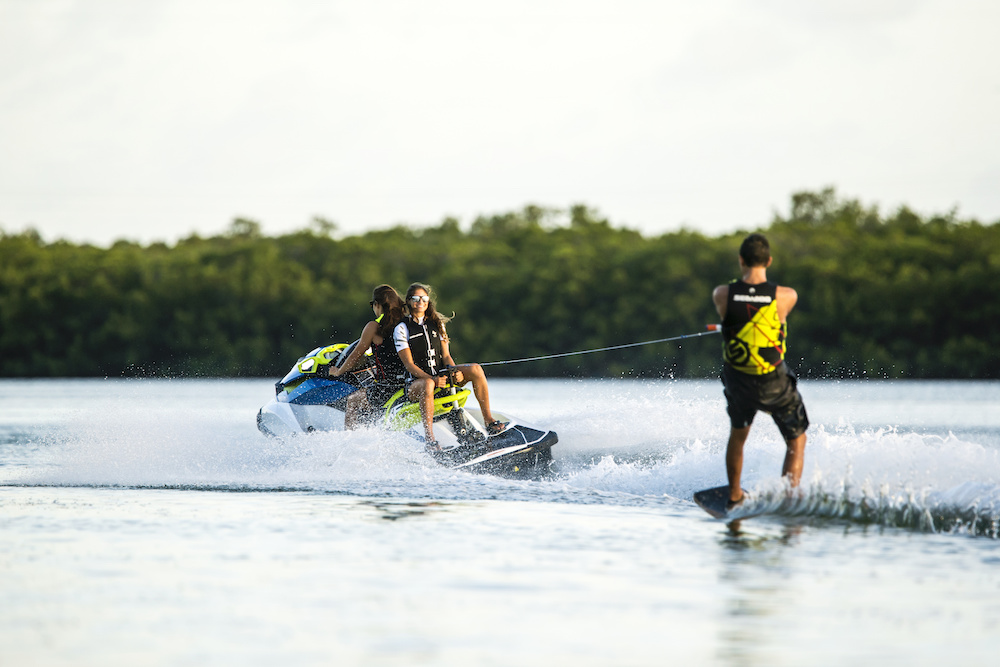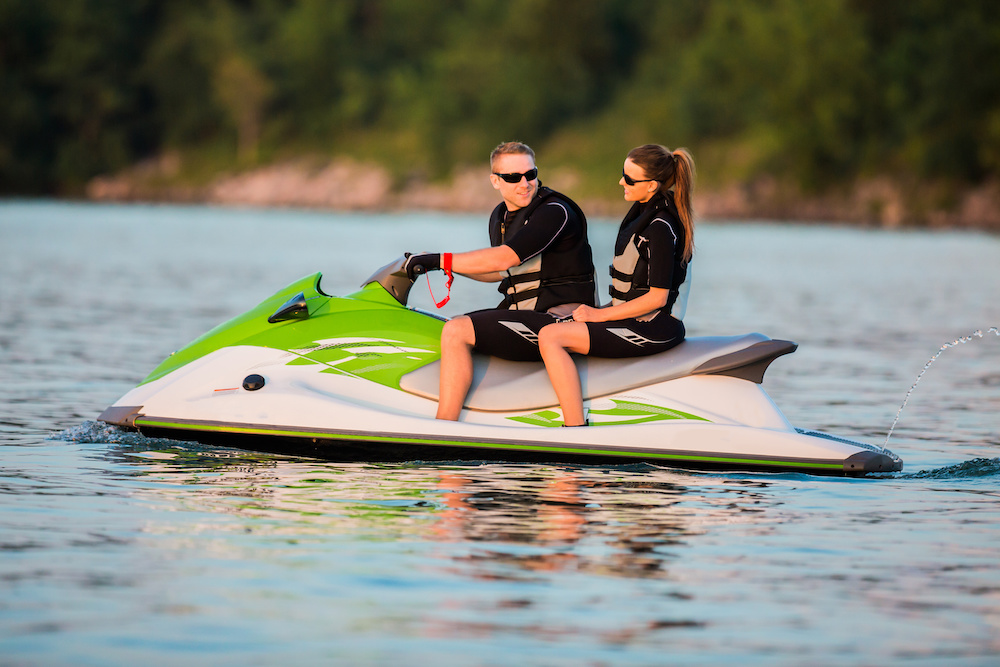According to Pennsylvania Law, During What Hours Is It Legal to Operate a Personal Watercraft (Pwc)?
Personal watercrafts (PWCs), besides commonly referred to as their make names like Jet Ski, WaveRunner or Sea-Doo, have evolved from unique, niche vehicles to one of the most popular categories of boats currently on the water. Just while the fun factor is high, and cost and hassles comparatively low, PWC should never be dismissed equally a big child's toy. Their unique blueprint, propulsion, and maneuverability demand that operators both understand and respect the craft's abilities.
Here'due south how to have a fun—and safe—PWC experience.
Before You Ride
- Familiarize yourself with the owners' manual and all safe warnings, paying particular attention to the operation of the jet jump.
- PWC manufacturers recommend neoprene shorts or wetsuits to protect lower-body openings from impact with the h2o during a high-speed autumn or the powerful thrust produced by the pump.
- Never attempt to board when the engine is running, and continue loose habiliment and long pilus clear of the pump intake.
- As with whatever type of boating, thoroughly understand boating laws and the rules of the road. Many states impose stricter historic period restrictions on personal watercraft apply. Check local canoeing laws for the specifics in your expanse.
- Different size PWC have unlike passenger and weight capacities; exceeding either could negatively affect the handling of the arts and crafts.
- Familiarize yourself with the handlebar steering, throttle control and safe lanyard. Never operate a PWC without the safety lanyard attached to both craft and driver's wrist or life jacket. Remove the lanyard whenever the craft is unattended to forbid unauthorized apply.
- Commuter and passengers should ever wear a Declension Guard-approved life jacket.
- Eyewear will block the force of current of air and water spray that could impair vision.
- Gloves and footwear offer welcome additional grip and traction.
- Wetsuits or windbreaker-style jacket/pant combos are advisable for libation weather considering PWC riders are far more exposed to the elements than the typical boater.
Familiarizing Yourself with Your Personal Watercraft
Have time to familiarize yourself with a PWC'due south unique handling. Cull a tranquillity expanse and practice using the throttle, carving through turns, and coming to a stop. If equipped, put the craft into reverse and annotation how it steers when backing.
Sympathise that throttle is required to make a plough. Rather than a rudder, personal watercraft employ directed thrust produced by the jet pump to steer. If you stop that thrust past releasing the throttle or stopping the engine, the commuter will lose directional control over the arts and crafts. Because releasing the throttle and turning the handlebars fully to one side is a common reaction in a collision-avoidance situation, manufacturers long ago addressed this scenario by having craft automatically employ a small amount of thrust should the commuter perform those actions. That minimal amount of thrust is enough to initiate a turn in the direction the commuter intended and perchance avoid an obstruction, but transmission throttle input is essential for true directional command.

Like any boat, a PWC volition not rapidly slow but rather will coast to a gradual stop when the throttle is released. In the case of a fast-moving PWC, that distance tin be 250 anxiety or more. Many newer models provide stopping ability by electronically linking the reverse bucket to a handlebar-mounted control lever. Applying the lever at higher speeds drops that bucket partially into the flow of h2o exiting the craft'southward jet pump, redirecting thrust forward and to the sides to rapidly slow forrard motion.
Safely Riding Your PWC, Jet Ski, WaveRunner or Sea-Doo
- Pay close attention to nearby boat traffic, remembering that other boaters might not exist prepared for a PWC'due south quick response and brusque turning radius.
- Before initiating a plough, expect to both sides, likewise as behind, to make sure no boats are overtaking your arts and crafts.
- Ever give other boaters ample space, too as stay a prophylactic distance from shore.
- Never follow directly behind some other watercraft, jump boat wakes, or attempt to spray other boaters, swimmers or beachgoers. Falls can and will happen, especially during the learning process. Should y'all start to fall, don't be tempted to hang on. It'due south safer to get clear of the watercraft. Re-lath only with the engine off, with the driver boarding first and so passengers.
- In the event the craft flips, look for a sticker on the stern detailing the proper way to flip the craft upright to avert engine damage.
- Though a PWC might be able to operate in shallow atmospheric condition, avoid environmentally sensitive areas. While PWC might not have whatever rudder or propeller extending below the hull bottom, the extreme force per unit area of h2o exiting the jet pump tin can all the same do damage in shallow conditions. Riding in shallow waters can also cause damage to your craft because the suction of the pump tin draw in sand, rocks and other debris in waters less than iii feet deep.
Finally, never operate a personal watercraft at night. Non only are personal watercraft not equipped with navigation lights, their unique design exposes riders to a greater chance of falling off the craft, a situation that could be dangerous in low visibility.

Required Safety Equipment for a PWC
- A life jacket for each operating passenger, and person existence towed
- A Coast Guard-approved B-1 fire extinguisher
- An canonical sound-signaling device such as a whistle or horn
- An emergency engine cutoff lanyard attached to the operator
- Proper display of registration numbers, letters and validation decals
- Vessel registration, to exist displayed when requested
- A operation backlash flame arrestor and passive ventilation arrangement
Recommended Safety Equipment
- Hand-held VHF radio, and a prison cell phone every bit a backup
- A basic first-assistance kit, sunscreen, and burn foam
- A dewatering device such every bit a mitt operated bilge pump
- An ballast and enough anchor line for your area
- If pulling a skier or other tow-sport participant, a skier-down flag, ano server over a certain age, and rear–view mirrors may also exist required. Even if they're not required, they're good to have.
- And finally, when operating on inland waters, it's recommended yous have a suitable, daytime distress signal such as flares, an orange flag, or signal mirror.
Read Next: Boating Safe Guide
Interested in learning more safe tips, or learning more about PWCs? Read...
- Explore Personal Watercraft (PWC) Brands & Manufacturers
- Buying a Personal Watercraft (PWC): Beginner's Guide
- Life Jackets, Vest & PFDs: How to Cull the Correct Fit
- Safe Canoeing Tips
- Watersports Safety Guide
Editor's Note: This article was originally published in May 2017 and updated in Oct 2019. Content collaboration with writer, Jeff Hemmel, and some content provided by BoatUS.
Category: Twenty-four hours Cruising
hodgkinsonforit1992.blogspot.com
Source: https://www.discoverboating.com/resources/personal-watercraft-safety-and-you
0 Response to "According to Pennsylvania Law, During What Hours Is It Legal to Operate a Personal Watercraft (Pwc)?"
Post a Comment